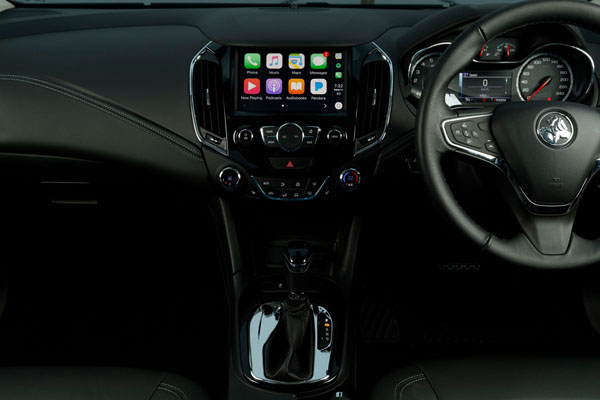
Home-grown Holdens may have been consigned to the realm of the dinosaur, but the Australian arm of General Motors is keeping up with the times, cherry picking the latest vehicles from around the globe.
A recent arrival Down Under is the Astra sedan, which slots nicely into the gap between the hatchback, launched late last year, and the wagon, to be unveiled by year’s end.
It makes sense, for in these days of sporty hatches, sleek coupes and versatile SUVs, there still appears to be a place for the traditional sedan, with its three-box structure making for a secure (lockable) boot, keeping stuff out of sight.
The new Astra is also a world away from the old idea of a sedate sedan. Designed in North America, engineered in Europe and manufactured in South Korea, Holden’s Aussie engineers had their two-pennyworth of input, getting their hands on the damper, chassis controls and steering tuning to give the locals what they want.
The get-up-and-go is supplied by an all-aluminium 1.4-litre turbocharged engine, putting out 110 kW of power and up to 245 Nm of torque. The Astra sedan comes in four spec levels – LS, LS+, LT and LTZ – and is one of the most spacious in the field of small cars.
The latest technology is on hand to provide a high level of driver assistance and a five-star safety rating is augmented by aids such as rear-view camera and rear park assist as standard, while upper spec models get added extras including lane keep assist, forward collision alert and blind spot alert.
Prices begin at $21,990 drive away for the LS manual, while the range is topped off at $29,790 for the LTZ automatic. The latter was the test vehicle.
STYLING
An extension of the Chevrolet Cruze design, the radiator grille has been given an Aussie slant with input from GM designers Down Under, adding as Holden tells us, “maturity and sophistication’ and an instantly recognisable point of difference from the corresponding hatchback.”
Looks apart, practicality holds sway with a slimmed down structure up to 120 kg lighter than the model it replaces. Aerodynamics benefit as well with a co-efficient of friction (Cd) of 0.30.
INTERIOR
There’s no ignoring the fact that the Astra is a small car and not so welcoming for five grown-ups, with shoulder and leg room more suited to Mum, Dad and up to three pre-teen children.
Remote entry and push-button engine firing get things off to an easy start, while and electric sunroof opens up the cabin to fresh air and natural light, while heated leather seats are there to take the chill off an early morning winter start.
INFOTAINMENT
The LTZ takes advantage of an 8-inch colour touchscreen (lower grades make do with a 7-inch) with Apple Carplay and Android Auto compatibility, plus embedded satellite navigation.
ENGINES / TRANSMISSIONS
The only powerplant on offer is a 1.4-litre turbocharged petrol engine, producing 110 kW of power and up to 245 Nm of torque mated with a six-speed automatic transmission.
SAFETY
A total of six airbags include dual front, side and curtain examples. Electronic stability control is joined by ABS anti-skid brakes, traction control and hill start assist. A rear view camera and rear park assist are standard across the range, while LTZ also takes advantage of front park assist.
Also incorporated in LTZ is Holden Eye, a forward facing camera featuring lane keep assist, lane departure warning, forward collision alert, forward distance indicator and blind spot alert.
DRIVING
Spritely, spacious and versatile, the Holden Astra is all of the above, and has not missed out in the good looks department. Fuel economy is near the top of the segment too with the test car recording 9 litres per 100 kilometres in day-to-day city driving and a little over half that at motorway speeds.
Holden says its engineers focused on tuning Astra sedan to be comfortable on poor quality bitumen, railway and tram tracks, and unsealed roads with broken surfaces – par for the course in our part of the world. The test vehicle ticked all the boxes on a varied but none too extreme examples.
Added confidence came with precise steering and chassis controls giving a direct feedback and allowing the driver time to react accordingly. This showed the 100,000 kilometres of private and public testing on home soil was far from wasted.
Holden Astra boasts a class-leading 445 litres of boot volume. And with 1200 kg towing capability and trailer sway control it is not left behind in practicality.
SUMMING UP
While the Astra sedan is aimed at the niche market of mature owners with no kids, it has called on a world of creativity in design and technology to set it apart from others in the small-car market.
AT A GLANCE
MODEL RANGE
Astra LS manual sedan $20,490 ($21,990 drive away)
Astra LS auto $21,490 ($23,990)
Astra LS+ auto sedan $22,740 ($24,990)
Astra LT auto sedan $25,790 ($27,990)
Astra LTZ auto sedan $29,790
SPECIFICATIONS (Holden Astra Ecotec 1.4-litre turbocharged four-cylinder petrol sedan)
ENGINE:
Capacity: 1.399 litres
Configuration: Four cylinders in line
Maximum Power: 110 kW @ 6500 rpm
Maximum Torque: 240 Nm @ 2000-4000 rpm
Fuel Type: Petrol 91 RON
Combined Fuel Cycle (ADR 81/02): 6.1 L/100km
CO2 Emissions: 141 g/km
DRIVELINE: Six-speed automatic
DIMENSIONS, WEIGHT AND CAPACITIES:
Length: 4665 mm
Wheelbase: 2700 mm
Width: 1807 mm
Height: 1457 mm
Turning Circle: 11.9 metres
Kerb Mass: 1318 kg
Fuel Tank Capacity: 52 litres
BRAKES:
Front: Ventilated disc
Rear: Solid disc
STANDARD WARRANTY:
Five years / 100,000 km













